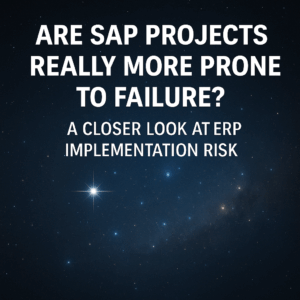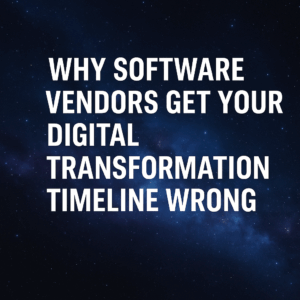Digital transformation can create significant stress for organizations and their employees, causing disruption in projects. It is important to understand these stressors and find ways to overcome them. In this article, we will explore the stressors of digital transformation and strategies for coping with them.
![How to Overcome Digital Transformation Pressure and Chaos [Sources of Stress and Ways to Cope] 1 YouTube player](https://i.ytimg.com/vi/Ff9LDW3ym0w/maxresdefault.jpg)
The majority of our work with clients involves assisting them in digital transformations, specifically during the implementation phase of a project. This phase involves the introduction of new technologies, process changes, and organizational changes. Unfortunately, many organizations are unprepared for the stressors associated with digital transformation and lack coping mechanisms. The purpose of this article is to identify major stressors and provide strategies for overcoming and mitigating risks and stresses.
Table of Contents
ToggleFear, Uncertainty and Doubt
One major stressor of digital transformation is fear, uncertainty, and doubt (FUD). When jobs are changed, removed, or disrupted, it can generate FUD. This is especially true when the changes are unknown. Digital transformations exacerbate this problem because although people within the organization may support the transformation, they may not comprehend its impact on their job or what their future job will look like. In the absence of this information, FUD can cause chaos, turmoil, and stress within the organization.
![How to Overcome Digital Transformation Pressure and Chaos [Sources of Stress and Ways to Cope] 2 YouTube player](https://i.ytimg.com/vi/ZvNh7hHbdi0/maxresdefault.jpg)
Transformation Chaos
Transformations are typically chaotic, whether necessary or self-inflicted. Organizations experience chaos when they lose control over the technology being built for them by the system integrator or software vendor, which may come at a high cost with questionable business value. Additionally, employees may be uncertain about their job’s future and what it will entail, contributing to a sense of loss of control. This feeling of loss of control can lead to more chaos, which can be further exacerbated when multiple individuals are experiencing the same fear and chaos. It is crucial to recognize this and incorporate it into digital transformation and change management strategies.
Disconnect Between Theory and Reality
One of the main reasons for stress during transformations is that organizations and their employees often have an idealistic view of what the future state will look like and fail to plan for the stress that comes with the transformation journey. While they may understand the end goal, they often underestimate the difficulty of the actual transformation process, leading to a disconnect between theory and reality. Additionally, the project plan provided by software vendors or system integrators is frequently overly optimistic, leading to stress and chaos when the organization realizes the plan was not realistic halfway through the project. These are just a few examples of how the disconnect between theory and reality can create stress and chaos within organizations.
Culture Shock
One stressor in digital transformations is culture shock. Introducing new technologies, automation, and ways of doing business changes your culture. It affects and changes your culture. For example, let’s say your organization is highly decentralized, entrepreneurial, and flexible, and succeeds due to the heroics of some individuals. But then, you introduce new technologies that cause you to be more standardized, structured, and less flexible. That’s a cultural shift and shock that creates stress within the organization. Therefore, it’s important to recognize that introducing new technologies, processes, and ways of doing business can put your organization through culture shock during the digital transformation.
Organization and Vendor Misalignment
The primary stressor in digital transformation is a lack of alignment within the organization. This means that people within the organization are not working toward the same goal. They have diverse perspectives and interpretations of what the project means to the organization. They have different priorities and become embroiled in political conflicts, causing confusion, disorder, and obstacles to the overall transformation. This can cause a lot of stress for individuals involved in the organization.
Organizational misalignment is another stressor in digital transformations. The software vendor and system integrator have a self-interest to implement as much software as possible as quickly as possible to make money, which may not align with the organization’s goals. The organization’s priority is to deliver the project on time, on budget, minimize operational disruption, and maximize business value. When there is a misalignment between the organization and the software vendor, it creates chaos and stress within the organization.
![How to Overcome Digital Transformation Pressure and Chaos [Sources of Stress and Ways to Cope] 3 YouTube player](https://i.ytimg.com/vi/injlyC-Sk3Y/maxresdefault.jpg)
Solutions For Overcoming Stressors
So, I have shared with you a handful of stressors that often happen during a digital transformation, but the more important question is: what do we do about it? How do we mitigate the stress? How do we neutralize it? How do we overcome those stressors? And that is what I want to talk about next. First and foremost, you want to make sure you have realistic expectations when you go into a digital transformation. So much of what I have talked about in this article is a result of not having those realistic expectations. We did something up front or made decisions up front that were not based on reality – it is an implementation plan and a set of assumptions that were never realistic, but yet you thought it was, and therefore that creates a certain amount of stress. So, if we can get to the root cause of that and just make sure we have realistic expectations up front, then we are going to solve a large part of that problem.
Having clarity on the overall direction of a digital transformation project can help minimize stress and chaos. This means articulating a set of priorities that align with broader business goals and objectives, and ensuring that everyone in the organization understands them. If you can’t answer these questions, it may be too early to start the project. Getting clarity and alignment upfront can save time, money, and stress later on.
A third measure to mitigate stress and chaos during a digital transformation is to develop an effective organizational change strategy. Even if you have set realistic expectations and achieved good alignment, you may still encounter resistance to change and other change management issues. Having a well-designed and tailored change strategy and plan can help overcome these challenges and alleviate stress and chaos during the digital transformation.
Finally, it is essential to ensure that you have a robust project governance structure in place and a way to manage your vendors. This means that you need to have safety precautions in place to ensure that the project stays on track. You should not allow your software vendor or system integrator to manage the project for you or dictate how you should run your business. Taking control of the project and managing the software vendors and third-party consultants yourself can help you minimize stress and chaos. If you need assistance with any of these solutions, independent technology-agnostic providers like Third Stage Consulting can help.
Consider hiring a third-party consulting firm like Third Stage Consulting to help you manage the stress and chaos of a digital transformation. Understanding the potential stressors and having a plan in place to address them can also help.
These are the decision points that organizations must go through to determine the best fit for their needs. If you are looking to strategize an upcoming transformation or are looking at selecting an ERP system, we would love to give you some insights. Please contact me for more information eric.kimberling@thirdstage-consulting.com





